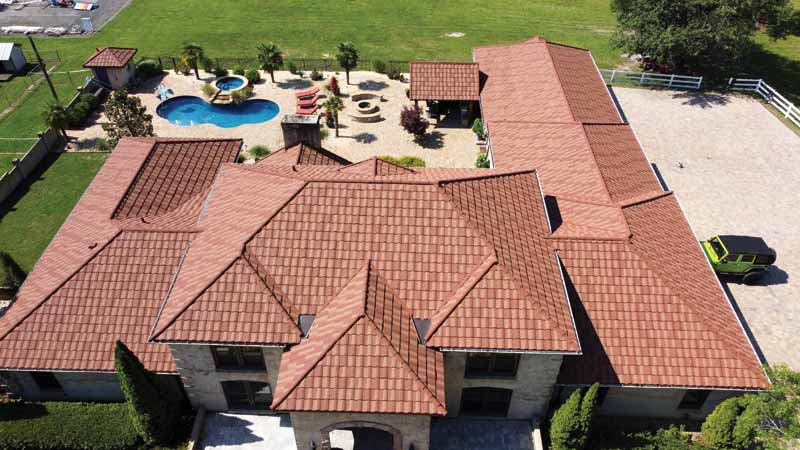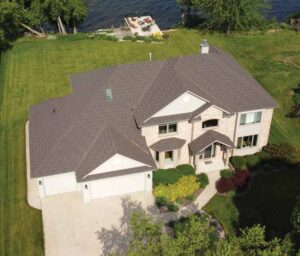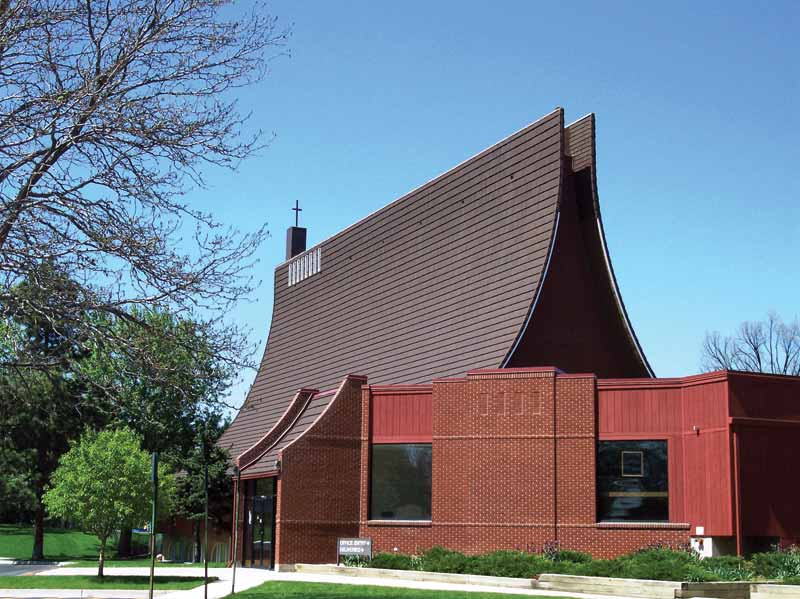
As severe weather events become more frequent and drastic, damage to homes and structures becomes more pronounced and costly. Hailstorms are on the rise in the United States, as weather patterns continue to shift. With the ability to cause serious injury to humans and animals, hail also notably causes significant physical damage to homes and commercial buildings, driving up insurance claims and user policies. Unsurprisingly, the roof, siding, and windows are all common points of impact for hail. This article explores the relationship between hail and the roof, specifically examining the durability and performance of one type of metal steep slope roofing—stone-coated steel roofing—in the face of hail.
Hail 101
A form of precipitation, hail often accompanies thunderstorms, which are a common hazard in the United States due to the country’s geography. Hailstones, essentially solid ice balls, form when raindrops are carried upward by thunderstorm updrafts into extremely cold areas of the atmosphere and then freeze. Hailstones may also grow as they collide with liquid water drops, which then freeze onto the surface of the original hailstones. The hail eventually falls when the updraft is no longer able to carry its weight.
The speed at which hail falls depends on variables such as the size of the stone, the friction between the hail and the surrounding air, and the degree to which the hail melts. While many regions in the United States experience hail, the states with the highest number of hailstorms are Nebraska, Colorado, and Wyoming.1
A 2021 UN science report noted hail season appears to now be starting earlier than the historic norm and the frequency of larger hailstones is increasing across broad regions of the United States.2 Additionally, a recent CoreLogic report found that hail of two inches in size or greater hit the United States on 141 days in 2023. This represents the highest number of annual days in two full decades. Hail of at least 25-mm (1-in.) in size fell on an excess of 10 million residential homes from mid-March through November 2023.3
Hail insurance and losses

In 2023, there were a total of 28 weather and climate disasters that each caused more than $1 billion in losses within the United States. Overall, these events combined cost a total of $93.1 billion. Of all types of weather-related damage, hail and wind are now the leading cause of insurance claims, accounting for nearly 40 percent of homeowner-originated claims.4
Physical and monetary damages from hail are on the rise, in part because hail events are increasing in severity. However, damages from hail are also growing because
the human population is increasing in regions where hailstorms are common, essentially putting more property in harm’s way. With inflation still an ongoing issue, the financial implications of these losses are meaningful. In the end, they drive up costs for policyholders.5
The roof is often the first point of contact for hailstones, which can dent or crack roofing tiles and shingles. What may result are leaks, a roof that does not perform, and, ultimately, a reduced roof lifespan. Thus, as hail events and their damages grow, so too does the need for high-performance roofing that can withstand and protect against increased hail and weather events, as well as the damage they may cause.
Stone-coated steel and its resistance to hail

Stone-coated steel roofing refers to roofing tiles that are manufactured from Galvalume steel and then coated with stone granules that are applied with acrylic polymer adhesives. A steep slope metal roofing solution, stone-coated steel roofing is growing in popularity in the United States, not only because of the aesthetics it provides but also because of its durability and weather-resistance capabilities.
Weighing in at approximately 0.7 kg per m2 (1.5 lb per sf), the material is exceptionally lightweight, while still benefitting from the structural strength of the steel comprising it. Given these combined attributes, the material is ideal for use in both new construction and roof retrofits. In the latter case, concerns about whether older homes and structures will be able to handle the additional weight of the product are lessened because stone-coated steel weighs significantly less than other roofing options.
Stone-coated steel hail testing and Very Severe Hail Rating
To qualify as an FM4473-certified roofing product, steep slope roofing materials, including stone-coated steel roofing, must possess adequate physical properties to demonstrate hail impact resistance as it relates to hailstorms. The minimum accepted performance is a Class 2 nominal 38.1 mm (1.5 in) diameter ice ball. Classifications also include Class 3 nominal, or 44.5-mm (1.75-in)-sized ice ball, and Class 4 nominal, or 50.8-mm (2-in.)-sized ice ball. Certification for these ratings is contingent on two successful test specimens meeting the acceptable criteria to qualify for the given classification.
The Very Severe Hail (VSH) Rating is currently the highest rating available for steep slope roofing products. To qualify, 50.8-mm
(2-in.) ice balls are also used, however, the panels are weathered before testing. Additionally, three successful test specimens must meet the criteria. During both Class 4 and VSH testing, a 50.8-mm (2-in.) ice ball is shot at the test subject at different speeds, producing a set kinetic energy at impact. Class 4 shoots the ball to target kinetic energy of 36.3-N-m (26.8-ft-lbf) of force, while the VSH classification doubles that to 71.8-N-m
(53-ft-lbf) of force. To double the force in stone-coated steel roofing’s qualifying testing for VSH, the speed of the ice ball was increased from about
89 km/h (55 mph) to approximately 178 km/h (110 mph). To date, there is only one stone-coated steel product available in the United States that has achieved both the Class 4 and Very Severe Hail classifications.
Additional weather-resistance attributes of stone-coated steel
Of course, hail is not the only weather event of concern. Stone-coated steel roofing protects from numerous additional and potentially damaging conditions including ice damming, snow loads, wind uplift, and fire. Following is a synopsis of the protection the material provides against each.
Ice damming
Following heavy snowfall in cold climates, warm air in the attic warms the roof, causing snow to melt. Water running down the roof refreezes when it reaches the colder roof edge, forming an ice mound. However, stone-coated steel roofing, installed with an elevated or above-sheathing ventilation (ASV) roof system, can help equalize the temperature between the snow and the structure, minimizing melt and freeze snow cycles and reducing ice dams.
Snow loads
Between the steel composition, panel profile, and installation methods, a stone-coated steel roof can carry more weight from snow loads than other roofing options, protecting the roof from costly damage. The properly supported panels do not delaminate, fracture, or break from the added weight that can accumulate from high levels of snowfall.

Wind uplift
With modular design, batten substructure, and fastening patterns, stone-coated steel has been proven to withstand severe wind events including various hurricanes and tropical storms. Some products offer warranty coverage for wind speeds up to 193 km/h (120 mph) and are tested to meet codes for the most stringent wind regions, including in Miami Dade County, Fla., where requirements reach as high as 289 km/h (180 mph).
Fire
As shown by testing results to ASTM-E108, stone-coated steel roofing also helps protect structures from fire spread. The material offers a Class-A fire rating when used with specific underlayment materials, providing
extra protection from wind-driven embers, which are common during urban firestorms, and which can pose a risk if they meet the home’s roof.
The bottom line is that a stone-coated steel roofing system, when installed with the proper underlayment and attachment process, will provide safety, comfort, and protection from some of the most severe climate conditions. Notably, it can also be installed in any weather, even severe cold, allowing contractors to get their project completed with a reduced likelihood of weather-related installation delays.
Optimizing stone-coated steel for energy savings
In addition to its hail and additional weather resiliency attributes, stone-coated steel roofing may also notably be used as part of a complete cool roof system to reduce the home or structure’s energy consumption and to achieve meaningful, long-term energy savings. A stone-coated steel “cool roof” system will encompass a suite of key components including a high-performance underlayment, an elevated batten system, and a variety of hip and ridge ventilation products. Additionally, an effective “cool roof” incorporates ASV. All “cool roof” system elements work in concert to create a cooler attic and a much more comfortable interior living space.
Notes:
1Severe Weather 101 – Hail, NOAA National Severe Storms Laboratory, July 16, 2024, https://www.nssl.noaa.gov/education/svrwx101/hail/
2 Insurers Hit Hard as US Hailstorms Frow More Severe, Costly in Warming Climate, S&P Global, August 14, 2023, https://www.spglobal.com/marketintelligence/en/news-insights/latest-news-headlines/insurers-hit-hard-as-us-hailstorms-grow-more-severe-costly-in-warming-climate-76991910
3 That’s Gonna Leave a Mark: Large-Hail Days Hit Two-Decade high in 2023, Insurance Journal, February 22, 2024, https://www.insurancejournal.com/news/national/2024/02/22/761760.htm#
4 Storm Damage Insurance Claims are on the Rise, Nationwide, June 10, 2024, https://agentblog.nationwide.com/personal-lines-insights/risk-prevention/help-customers-mitigate-storm-related-risk/
5 Storm Damage Insurance Claims are on the Rise, Nationwide, June 10, 2024, https://agentblog.nationwide.com/personal-lines-insights/risk-prevention/help-customers-mitigate-storm-related-risk/
Robin Anderson is the technical and strategy development manager with Westlake Royal Building Products / Roofing Solutions. Anderson specializes in the technical and performance of primary roofing installation practices with an emphasis on how they meet building codes and standards. He has over 35 years of experience in manufacturing, installation, code compliance testing, and technical writing. In his current role with Westlake Royal Building Products / Roofing Solutions, Anderson works in conjunction with the production and quality control teams at the Unified Steel Stone Coated Roofing plant to ensure product quality, as well as collaborates regularly with the sales and training departments. Anderson is a member of the technical committee of the Metal Construction Association, Metal Roofing Alliance, and Tile Roof Industry Alliance. He also participates with RICOWI in investigations of extreme weather events. Contact him at randerson3@westlake.com or visit www.westlakeroyalroofing.com





